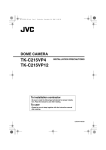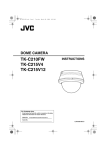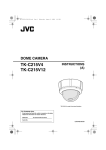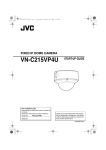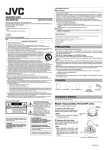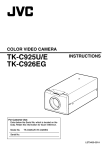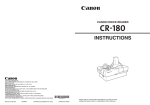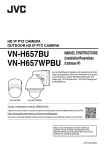Download JVC TK-C215VP4E surveillance camera
Transcript
TK-C215VP4_JP.book Page 1 Thursday, November 2, 2006 10:51 AM DOME CAMERA TK-C215VP4U/E TK-C215VP12U/E INSTRUCTIONS For Customer Use: Enter below the Serial No. which is located on the body. Retain this information for future reference. Model No. TK-C215VP4U/E,TK-C215VP12U/E Serial No. LST0519-001A TK-C215VP4_JP.book Page 2 Thursday, November 2, 2006 10:51 AM Introduction These are general IMPORTANT SAFEGUARDS and certain items may not apply to all appliances. IMPORTANT SAFEGUARDS 1. 2. 3. 4. Read all of these instructions. Save these instructions for later use. All warnings on the product and in the operating instructions should be adhered to. Unplug this appliance system from the wall outlet before cleaning. Do not use liquid cleaners or aerosol cleaners. Use a damp cloth for cleaning. 5. Do not use attachments not recommended by the appliance manufacturer as they may cause hazards. 6. Do not use this appliance near water - for example, near a bathtub, washbowl, kitchen sink, or laundry tub, in a wet basement, or near a swimming pool, etc. 7. Do not place this appliance on an unstable cart, stand, or table. The appliance may PORTABLE CART WARNING fall, causing serious injury to a child or adult, and serious damage to the appliance. (symbol provided by RETAC) Use only with a cart or stand recommended by the manufacturer, or sold with the appliance. Wall or shelf mounting should follow the manufacturer's instructions, and should use a mounting kit approved by the manufacturer. An appliance and cart combination should be moved with care. Quick stops, excessive force, and uneven surfaces may cause the appliance and cart combination to overturn. 8. Slots and openings in the cabinet and the back or bottom are pro-vided for S3125A ventilation, and to insure reliable operation of the appliance and to protect it from overheating, these openings must not be blocked or covered. The openings should never be blocked by placing the appliance on a bed, sofa, rug, or other similar surface. This appliance should never be placed near or over a radiator or heat register. This appliance should not be placed in a built-in installation such as a bookcase unless proper ventilation is provided. 9. This appliance should be operated only from the type of power source indicated on the marking label. If you are not sure of the type of power supplied to your home, consult your dealer or local power company. For appliance designed to operate from battery power, refer to the operating instructions. 10.For added protection for this product during a lightning storm, or when it is left unattended and unused for long periods of time, unplug it form the wall outlet and disconnect the antenna or cable system. This will prevent damage to the product due to lightning and power-line surges. 11.Do not allow anything to rest on the power cord. Do not locate this appliance where the cord will be abused by persons walking on it. 12.Follow all warnings and instructions marked on the appliance. 13.Do not overload wall outlets and extension cords as this can result in fire or electric shock. 14.Never push objects of any kind into this appliance through cabinet slots as they may touch dangerous voltage points or short out parts that could result in a fire or electric shock. Never spill liquid of any kind on the appliance. 15.Do not attempt to service this appliance yourself as opening or removing covers may expose you to dangerous voltage or other hazards. Refer all servicing to qualified service personnel. 16.Unplug this appliance from the wall outlet and refer servicing to qualified service personnel under the following conditions: a. b. c. d. When the power cord or plug is damaged or frayed. If liquid has been spilled into the appliance. If the appliance has been exposed to rain or water. If the appliance does not operate normally by following the operating instructions. Adjust only those controls that are covered by the operating instructions as improper adjustment of other controls may result in damage and will often require extensive work by a qualified technician to restore the appliance to normal operation. e. If the appliance has been dropped or the cabinet has been damaged. f. When the appliance exhibits a distinct change in performance - this indicates a need for service. 17.When replacement parts are required, be sure the service technician has used replacement parts specified by the manufacturer that have the same characteristics as the original part. Unauthorized substitutions may result in fire, electric shock, or other hazards. 18.Upon completion of any service or repairs to this appliance, ask the service technician to perform routine safety checks to determine that the appliance is in safe operating condition. 2 TK-C215VP4_JP.book Page 3 Thursday, November 2, 2006 10:51 AM Safety Precautions FOR USA AND CANADA INFORMATION FOR USA INFORMATION CAUTION RISK OF ELECTRIC SHOCK DO NOT OPEN CAUTION : TO REDUCE THE RISK OF ELECTRIC SHOCK. DO NOT REMOVE COVER (OR BACK). NO USER-SERVICEABLE PARTS INSIDE.REFER SERVICING TO QUALIFIED SERVICE PERSONNEL. The lightning flash wish arrowhead symbol, within an equilateral triangle isintended to alert the user to the presence of uninsulated "dangerous voltage" within the product's enclosure thatmay be of sufficient magnitude to constitute a risk of electric shock to persons. The exclamation point within an equilateral triangle is intended to alert theuser to the presence of important operating and maintenance (servicing) instructions in the literature accompanying the appliance. INFORMATION (FOR CANADA) RENSEIGNEMENT (POUR CANADA) This Class B digital apparatus complies with Canadian ICES-003. Cet apparéil numerique de la Classe B est conforme à la norme NMB-003 du Canada. WARNING: TO REDUCE THE RISK OF FIRE OR ELECTRIC SHOCK, DO NOT EXPOSE THIS APPLIANCE TO RAIN OR MOISTURE. AVERTISSEMENT: POUR EVITER LES RISQUES D'INCENDIE OU D'ELECTROCUTION, NE PAS EXPOSER L'APPAREIL A L'HUMIDITE OU A LA PLUIE. This equipment has been tested and found to comply with the limits for a Class B digital device, pursuant to Part 15 of the FCC Rules. These limits are designed to provide reasonable protection against harmful interference in a residential installation. This equipment generates, uses, and can radiate radio frequency energy and, if not installed and used in accordance with the instructions, may cause harmful interference to radio communications. However, there is no guarantee that interference will not occur in a particular installation. If this equipment does cause harmful interference to radio or television reception, which can be determined by turning the equipment off and on, the user is encouraged to try to correct the interference by one or more of the following measures: 0 Reorient or relocate the receiving antenna. 0 Increase the separation between the equipment and receiver. 0 Connect the equipment into an outlet on a circuit different from that to which the receiver is connected. 0 Consult the dealer or an experienced radio/TV technician for help. CAUTION CHANGES OR MODIFICATIONS NOT APPROVED BY JVC COULD VOID USER'S AUTHORITY TO OPERATE THE EQUIPMENT. THIS DEVICE COMPLIES WITH PART 15 OF THE FCC RULES. OPERATION IS SUBJECT TO THE FOLLOWING TWO CONDITIONS: (1) THIS DEVICE MAY NOT CAUSE HARMFUL INTERFERENCE, AND (2) THIS DEVICE MUST ACCEPT ANY INTERFERENCE RECEIVED, INCLUDING INTERFERENCE THAT MAY CAUSE UNDESIRED OPERATION. Due to design modifications, data given in this instruction book are subject to possible change without prior notice. 3 TK-C215VP4_JP.book Page 4 Thursday, November 2, 2006 10:51 AM Introduction Safety Precautions (continued) Information for Users on Disposal of Old Equipment [European Union] This symbol indicates that the electrical and electronic equipment should not be disposed as general household waste at its end-of-life. Instead, the product should be handed over to the applicable collection point for the recycling of electrical and electronic equipment for proper treatment, recovery and recycling in accordance with your national legislation. By disposing of this product correctly, you will help to conserve natural resources and will help prevent potential negative effects on the environment and human health which could otherwise be caused by inappropriate waste handling of this product. For more information about collection point and recycling of this product, please contact your local municipal office, your household waste disposal service or the shop where you purchased the product. Attention: This symbol is only valid in the European Union. Penalties may be applicable for incorrect disposal of this waste, in accordance with national legislation. (Business users) If you wish to dispose of this product, please visit our web page www.jvc-europe.com to obtain information about the take-back of the product. [Other Countries outside the European Union] If you wish to dispose of this product, please do so in accordance with applicable national legislation or other rules in your country for the treatment of old electrical and electronic equipment. Dear Customer, This apparatus is in conformance with the valid European directives and standards regarding electromagnetic compatibility and electrical safety. European representative of Victor Commany of Japan Limited.is: JVC Technology Centre Europe GmbH P.O.Box 10 05 52 61145 Friedberg Germany 䢇 The unit is to be powered by a DC 12 V or an AC 24 V power supply. 䢇 The unit is to be powered by a UL Listed DC 12 V or an AC 24 V power supply. (For U type) 䢇 The AC 24 V and 12 V DC power supply shall conform to the following: Class 2 only (For USA), Isolated power supply only (For Europe). 䢇 This installation should be made by a qualified service person and should conform to all local codes. 䢇 This installation shall be in accordance with the National Electrical Code, ANSI/NFPA 70. 4 䢇 Any Mention in this manual of Alarm inputs have not been evaluated by UL to be used for Burglar Alarm Functionality. 䢇 When mounting this unit to the ceiling or wall, mount it to a secure location where it can support the mass of this unit. When mounting to an insecure location, make sure to carry out reinforcement of the ceiling or wall before installation. 䢇 The rating label is placed on the bottom surface of the camera unit. 䢇 The camera unit may fall if the mounting screw or piping is not properly tightened. Ensure that the screws and nuts are properly tightened. 䢇 We do not accept liability for any damage to the camera in cases when it is dropped because of incomplete installation due to not observing the installation instructions correctly. Please be careful when installing the camera. 䢇 Do not install the camera near lighting equipment with a high temperature, such as spotlights. Doing so may cause malfunction or fire. TK-C215VP4_JP.book Page 5 Thursday, November 2, 2006 Thank you for purchasing this product. (These instructions are for: TK-C215VP4U/TKC215VP4E/TK-C215VP12U/TK-C215VP12E.) Before beginning to operate this unit, please read the instruction manual carefully in order to make sure that the best possible performance is obtained. Characteristics 䡵 Excellent dust-proof and water-proof performance With the dust-proof and water-proof structure, it can be installed outdoor directly as it will not be affected by the rain. (IP66 specification) 10:51 AM This instruction manual covers total 4 different models in common as follows: TK-C215VP4U TK-C215VP4E TK-C215VP12U TK-C215VP12E In this manual, each model number is described without the last letter (U/E) which means the shipping destination. (U: NTSC, E: PAL) Only “U”models (TK-C215VP4U/TKC215VP12U) have been evaluated by UL. 䡵 Realizing a High Picture Quality This camera provides 540 TV lines with a S/N ratio of 50 dB. This performance is achieve by using a highly sensitive CCD with 380,000 pixels (U type) or 440,000 pixels (E type) and a highresolution video processing circuit. 䡵 Enlarged Shooting Range The adjustment range of the shooting direction is wide and mounting of the camera to the wall is possible with the employment of 3 axis rotation mechanism. 䡵 Non Camera-Like Design Dome-type design allows application in various locations. 䡵 High Magnification Varifocal/Zoom Lens The built-in x3.6 varifocal lens (TK-C215VP4U/ E) and x12 zoom lens (TK-C215VP12U/E) enables detailed supervision. 䡵 Alarm Zoom Feature (TK-C215VP12U/E only) 2 preset positions are available, which allow setting of the monitoring screen size under normal circumstances and during alarm input. How to Use This Manual 䡵 Characters and symbols used in this manual Note Memo 䡵 Easy DAY & NIGHT Feature This camera has an Easy Day & Night function. This function, if activated, will automatically switch to B&W image when the scene is getting dark. This is very useful for monitoring a dark environment. A : Points to pay attention to during operation. : Details for reference, such as functions or constraints during use. : Pages or items to refer to. ● All product names that appear in this document are the trademarks or registered trademarks of their respective companies. Marks and symbols such as 姠, 姞 and 姝 do not appear in this document. 5 TK-C215VP4_JP.book Page 6 Thursday, November 2, 2006 10:51 AM Introduction Table of Contents Introduction Safety Precautions .................................... 3 Characteristics .......................................... 5 Table of Contents ...................................... 6 Precautions for proper use of this product ... 7 Name of Parts ........................................... 9 Setting the Switches and the Lens (TK-C215VP4U/E) ................................ 12 Setting the Switches and the Lens (TK-C215VP12U/E) .............................. 14 Installation and Connection System Example ..................................... 16 About Connection Cables ....................... 17 Video signal cables ............................. 17 DC 12 V or AC 24 V power supply cable ......................... 17 Electrical Specifications of Alarm Input Terminals ..................... 18 The right sequence to connect and set the camera ................................................. 19 Setting the switches ................................ 20 Mounting the base .................................. 21 Cable Connection ................................... 22 Mounting the camera unit ....................... 23 Adjusting the video image ...................... 25 Mounting the inner dome ........................ 30 Mounting the dome cover ....................... 30 Mounting the camera using the electrical box .................................. 31 Mounting the camera using the pipe ...... 32 White-spot correction .............................. 34 Others Specifications ......................................... 36 6 䢇 Before starting an important recording, be sure to perform a test recording in order to confirm that a normal recording is possible. 䢇 We will not provide any compensation whatsoever for the contents to be recorded or loss of opportunities when recording is not properly performed due to malfunction of the video camera, VTR, hard disk recorder or video tape. 䢇 Before touching the camera unit, make sure to touch the metal surface of the [MONITOR] terminal to discharge any static electricity from your body. Static electricity may cause the camera to malfunction. TK-C215VP4_JP.book Page 7 Thursday, November 2, 2006 Precautions for proper use of this product Storage and Location of Use 䢇 Do not install this unit at the following locations. ● Places that are exposed to vapor or oil, such as kitchens. ● Places that exceed the ambient temperature range (-10 I to 50 I). ● Places at which corrosive gases are emitted. ● Places where radiation or X-rays and strong radio waves or magnetism are present. ● Places that are subject to vibration. 䢇 Using this unit or cables connected to this unit in places where strong radio waves and magnetic fields are present (e.g. near a radio, TV, transformer or motor) may increase the noises in the image and color changes . 䢇 Do not install this unit at a place that is directly exposed to cold air or near the outlet of an air-conditioner. The dome cover may become foggy when there is a drastic change in temperature. 䢇 Although this unit is IP66-compliant, waterproof under all kinds of environment is not guaranteed. Others 䢇 This unit comes with a built-in AGC circuit. When the AGC function is turned on, the sensitivity increases automatically at a dark place and the screen may appear grainy. This is not a malfunction. 䢇 When using the Automatic Tracking White balance (ATW) mode, the color tone may differ slightly from the actual color. This slight color variation is caused by the principle of Auto Tracking White balance circuit and is not a camera malfunction. 䢇 When shooting an object with high brightness (lamps, etc.), vertical lines may appear in the image on the screen (smear phenomenon) and bleeding may be found around the high brightness object (blooming phenomenon). These are due to the characteristics of the CCD and not malfunctions. 10:51 AM 䢇 Turning AONB DAY & NIGHT function switches the image to black-and-white in a dark place. When switching between colored and black-and-white images, the bright portions of the screen are enhanced and the clarity of the screen may deteriorate. Overall the sensitivity increases in the case of blackand-white images, therefore the scene may appear grainy and white spots may become visible. This is not a malfunction. 䢇 When the power source voltage drops (such as during lightning or upon turning on the airconditioner) distortion or noise may occur in the image. 䢇 When this unit is moved from a cold to a warm place, dew condensation may occur, which may result in camera malfunctioning. In this case, leave this unit at room temperature for about 1 hour before turning on the power. 䢇 The rotation angle of this unit has been enlarged to enable installation at a wide variety of locations. When the zoom function of the lens is set to Wide and the tilt angle set close to ±70°, a portion of this unit may be visible on the shooting screen depending on the rotation angle. When this occurs, adjust the angle of view accordingly. (A Pg. 25) 䢇 To prevent fogging due to changes in temperature, make sure to insert the supplied silica gel into the designated location. (A Pg. 24) 䢇 When the supply voltage of the camera is low, the input protection circuit within the camera may be triggered and the power of the camera may turn off automatically. Make sure to use a power supply and voltage for the camera that is within -10 % of the rated voltage. 䢇 All Interconnecting Equipment must be UL Listed. 䢇 Upon switching between the HOME and ALARM positions, the camera focus may change slightly after the zoom operation comes to a stop. This is due to the built-in lens performance and is not a malfunction. (TK-C215VP12U/E only) 7 TK-C215VP4_JP.book Page 8 Thursday, November 2, 2006 10:51 AM Introduction Precautions for proper use of this product (continued) Maintenance 䢇 Turn off the power before performing maintenance. 䢇 Clean the dome cover using a lens cleaning cloth (or soft cloth). Wiping it with thinner or benzene may melt the surface or cause it to fog. For tough stains, wipe using a cloth that is dipped into a neutral detergent diluted with water, followed by wiping with a dry cloth. Energy Conservation 䢇 When not in use, turn off the power of the system to save energy. 8 䡵 Note on consumable parts (TK-C215VP12U/E only) The following parts are consumable and should be replaced after a certain number of hours or a count of operations. The service lives given below are only typical values. They may vary depending on the operating environment and conditions. Note that the replacement of consumable parts is chargeable even when they are replaced before the termination of the warranty period. 䢇 Zoom lens assembly Zooming operation: 2 million times TK-C215VP4_JP.book Page 9 Thursday, November 2, 2006 10:51 AM Name of Parts Camera A B C F D E A Mounting hole ⳯ 2 C Mounting Screw for Fall Prevention Wire Use these when mounting the camera to the ceiling, wall or electrical box. (A Pg. 21)(A Pg. 31) Use this screw when mounting the fall prevention wire to this unit. (Fall prevention wire is not supplied with this product.) Note: Note: ● To mount the camera using the electrical box, consult the dealer from which this product is purchased or any nearby JVC dealer. ● Connect the fall prevention wire to prevent this unit from falling accidentally. The camera unit may fall if this wire is not connected. B Hole for Connecting Cable and Piping D Dome Cover This is a hole for drawing out the connecting cable. This hole can also be used to mount directly to pipes. (Piping hole: G3/4-14UNC) (A Pg. 32) E Inner Dome Set the switches as well as angle of view before mounting the camera. (A Pg. 20) F Plug for Piping Hole and Piping Hole (Side) Use this plug when mounting directly to pipes from the side. The plug for piping hole is mounted to this hole by default. (A Pg. 33) 9 TK-C215VP4_JP.book Page 10 Thursday, November 2, 2006 10:51 AM Introduction Name of Parts (continued) Camera (continued) L K J TK-C215VP12U/E only I G H G Base J Alarm signal cable Mount the base to the ceiling, wall or electrical box before mounting the camera. (A Pg. 21)(A Pg. 31) (TK-C215VP12U/E only) H Fastening Screw for Dome Cover K Protection Cover This is a fastening screw for the dome cover. Use a supplied wrench to fasten/unfasten the screw. Upon connecting the video cable please protect the BNC connection using this rubber cover. I AC 24 V/DC 12 V Power Supply Wire DC 12 V Input: Red (+12 V), Black (GND) AC 24 V Input: Nonpolar Note: ● In order to use the optional heater unit sold separately (part number KA-ZH215) with this camera an AC 24 V power supply MUST be use. ● The AC 24 V power supply should conform to the following: U-type: Class 2 only E-type: Isolated power supply only ● For inquiries on the heater, consult your nearby JVC dealer. 10 Yellow (ALARM IN), Gray (ALARM GND). (A Pg. 18) L Video signal output connector (BNC) (A Pg. 17) TK-C215VP4_JP.book Page 11 Thursday, November 2, 2006 10:51 AM Camera (Interior) M Lens (A next page) Y X N W O P Q V R U S T *TK-C215VP4U/E is used in the above illustration M Rotation Knob ( TK-C215VP4U/E only) U Camera Unit Fastening Clip ⳯ 2 Rotate the lens unit to adjust the inclination of the image. (A Pg. 25) This clip is used for fastening the camera unit to the base. When removing the base, press toward the direction indicated by the arrow to release. (A Pg. 21) N Rotation Center Mark (A Pg. 25) O Fall Prevention Wire Use this to connect the base G to the dome cover D. P Camera Unit Fastening Screw ⳯ 2 V Tilt Fastening Screw Upon adjusting the angle of view, tighten the screw to ensure that camera’s angle of view does not go out of alignment when it is used at a location with strong vibration. (A Pg. 25) Use this to fasten the camera body R to the base G. To remove (A Pg. 21) W Shooting Direction Mark Q [MONITOR]Monitor Terminal (RCA Jack) X Lug Plate (A Pg. 25) Install the camera by aligning the shooting direction with the arrow mark. R Camera Unit This plate is used for fastening the silica gel. (A Pg. 24) S Connector for Power Supply of Heater Y Space for Silica Gel This is a power connector for use when the heater (sold separately: KA-ZH215) is mounted. (A Pg. 24) T Space for Heater Memo: ● When mounting the heater (sold separately: KA-ZH215), read the instruction manual of the heater carefully before mounting. 11 TK-C215VP4_JP.book Page 12 Thursday, November 2, 2006 10:51 AM Introduction Setting the Switches and the Lens (TK-C215VP4U/E) Set the video setting switches on the camera unit before mounting it. To set the switches, use a fine-tipped screwdriver. A F G RESET/ [SPOT] B R B LL PHASE C D E 1 2 3 4 5 6 7 8 O N 2 4 WHT. BAL. L IRIS LEVEL H FOCUS ADJUST A [RESET/SPOT] RESET/SPOT button When switch #8 is set to [RESET] position and this button is pressed, the value of the white balance or phase adjusted manually is reset to the default value. ● When switch 2 [SELECT] is set to WHT.BAL., the white balance is reset to the default value. When the switch is set to PHASE, the phase is reset to the default value. ● When switch #8 is set to SPOT: When this button is pressed, white spots are corrected. For instructions on correcting white spots, see AWhite-spot correctionB (A Pg. 34). B [R/B,+/-] R/B,+/- adjustment button This button is pressed when manually adjusting the white balance or when adjusting the vertical phase of the line lock. The function of this button is selected using the 2 [SELECT] switch. ● When manually adjusting the white balance: Press the R button to increase the red tint and decrease the blue tint. Press the B button to increase the blue tint and decrease the red tint. 12 Function Selection Switch Settings Chart (Characters in bold indicate factory settings) OFF 1 2 3 4 5 6 7 8 AGC SELECT SYNC WHT.BAL. BLC DAY/NIGHT RESERVED RESET/SPOT ON ON WHT.BAL. INT MANU ON ON SET TO OFF RESET SPOT OFF PHASE LL ATW OFF OFF ● When adjusting the phase: Press the + or - button to adjust the phase. C Function selection switches 1. [AGC] Auto-gain control switch. Setting this switch to AONB automatically increases the sensitivity even when the brightness of the subject is insufficient. (Default setting: ON) 2. [SELECT] WHT.BAL./PHASE setting switch. WHT.BAL. : The B [R/B,+/-] buttons are used as [R/B] adjustment buttons. PHASE : The B [R/B,+/-] buttons are used as [+/-] adjustment buttons. (Default setting: WHT.BAL.) TK-C215VP4_JP.book Page 13 Thursday, November 2, 2006 10:51 AM 3. [SYNC] Synchronization system selection switch. This switch sets the synchronizing system for the camera. INT: This is set for internal synchronization LL (Line Lock): The camera’s vertical synchronization is locked to the AC 24 V 60 Hz or 50 Hz power line frequency. When switching between multiple cameras using a switcher, selecting this mode and adjusting the vertical phase can reduce the monitor sync disturbances occur that when the camera image is switched. U type: 60 Hz only E type: 50 Hz only (Default setting: INT) 4. [WHT.BAL.] ATW/MANUAL selection switch. For selecting whether to adjust the white balance automatically or manually. When the setting is changed from manual to ATW, the setting values in the manual mode will be reset. The camera switches to the same mode as with pressing the [RESET] button. (Default setting: ATW) Memo: ● The white balance of this camera is preset to use under sunlight or halogen lamps, and may not be properly adjusted when used under artificial lights such as fluorescent lights. 5. [BLC] Backlight compensation switch. When the object is placed against the light, setting this to AONB increases the iris aperture by 1 stop and the object will appear brighter. (Default setting: OFF) 6. [DAY/NIGHT] Easy Day & Night switch. To capture a subject with continually changing brightness (day/night), set this switch to AONB. The camera automatically captures the image in color when the subject is bright, and in black and white mode when it is dark. (Default setting: OFF) Memo: ● When this item is set to AONB, the AGC feature will automatically be set to AONB regardless of the [AGC] Switch 1 setting. ● The Easy DAY & NIGHT feature on this camera uses a sensitized black and white mode unlike other black and white surveillance cameras that use infra-red lighting. ● Sensitivity increases in the case of black-andwhite images. The screen may therefore appear rougher and white spots may increase. 7. [RESERVED] Not used. Ensure to set this to AOFFB before using the camera. (Default setting: OFF) 8. [RESET/SPOT] RESET/SPOT CORRECTION selection switch. RESET: The [RESET/SPOT] button is used as a [RESET] button. SPOT: The [RESET/SPOT] button is used as a [SPOT] button. (A Pg. 34) (Default setting: RESET) D [IRIS LEVEL] Iris level adjustment For adjusting the level of the automatic aperture control lens. This adjustment only needs to be made when required. Use this to accommodate particular shooting conditions. To darken image: Counterclockwise (L side) To brighten image: Clockwise (H side) Memo: ● Prior to adjusting the aperture level, ensure to set the [AGC] Switch 1 of the function selection switch C to AOFFB. Otherwise, when the level is turned too far toward L, the AGC function activates increasing sensitivity and the picture may look uneven. E [FOCUS ADJUST] focus adjustment button Use this to adjust the lens focus. Upon pressing, the lens aperture will open up for about 30 seconds such that the depth of field becomes shallower, thus enabling focus to be easily adjusted. (A Pg. 26) Memo: ● The electronic shutter functions automatically upon pressing the focus adjustment button and the screen may flicker. However, this is not a malfunction. F Focus adjustment ring Move this to the left/right to adjust the focus. G Zoom adjustment ring Move this to the left/right to adjust the field angle. 13 TK-C215VP4_JP.book Page 14 Thursday, November 2, 2006 10:51 AM Introduction B [ZOOM / FOCUS,MEMORY] zoom, focus Setting the Switches and the Lens (TK-C215VP12U/E) RESET/[SPOT] B LL PHASE R L H LEVEL [MEMORY] WHT.BAL. TELE ZOOM/FOCUS NEAR ALARM POSITION 2 FAR WIDE 4 POSITION SELECT 1 2 3 4 5 6 7 8 A B C D IRIS Set the video setting switches on the camera unit before mounting it. To set the switches, use a fine-tipped screwdriver. E F G adjustment switches/position memory button Use the [JTELE] and [KWIDE] switches to zoom, and the [HFAR] and [INEAR] switches to adjust focus. (A Pg. 28) Press the [MEMORY] button to register the position. (A Pg. 28) C [ALARM POSITION] status indication LED Light off : Registration of home position is enabled Light on (red) : Lens initializing. Light on (green) : Registration of alarm position is enabled Blinking (green) : Position memory registration mode N memory registration completed (A Pg. 28) D [POSITION SELECT] POSITION SELECT button Press this button to switch between the home and alarm positions. Display on the status indication LED C will change accordingly. (A Pg. 28) E [RESET/SPOT] RESET/SPOT button Function selection switch setting table (Items in bold are factory position) OFF 1 2 3 4 5 6 7 8 AGC SELECT SYNC WHT.BAL. BLC DAY/NIGHT ALARM RESET/SPOT OFF PHASE LL ATW OFF OFF TRIGGER RESET ON ON WHT.BAL. INT MANUAL ON ON STATE SPOT A [IRIS LEVEL] Iris level adjustment For adjusting the level of the automatic aperture control lens. This adjustment only needs to be made when required. Use this to accommodate particular shooting conditions. To darken image: Counterclockwise (L side) To brighten image: Clockwise (H side) Note: ● Prior to adjusting the aperture level, ensure to set the 1 [AGC] Switch of the function selection switch G to AOFFB. Otherwise, when the level is turned too far toward L, the AGC function activates increasing sensitivity and the picture may look uneven. 14 When switch #8 is set to [RESET] position and this button is pressed, the value of the white balance or phase adjusted manually is reset to the default value. ● When switch 2 [SELECT] is set to [WHT.BAL.], the white balance is reset to the default value. When the switch is set to PHASE, the phase is reset to the default value. ● When switch #8 is set to SPOT: When this button is pressed, white-spots are corrected. For instructions on correcting white-spots, see AWhite-spot correctionB (A Pg. 34). F [R/B,+/-] R/B, +/- adjustment button This button is pressed when manually adjusting the white balance or when adjusting the vertical phase of the line lock. The function of this button is selected using the 2 [SELECT] switch. ● When manually adjusting the white balance: Press the R button to increase the red tint and decrease the blue tint. Press the B button to increase the blue tint and decrease the red tint. ● When adjusting the phase: Press the + or - button to adjust the phase. TK-C215VP4_JP.book Page 15 Thursday, November 2, 2006 G Function selection switches 1. [AGC] Auto-gain control switch. Setting this switch to AONB automatically increases the sensitivity even when the brightness of the subject is insufficient. (Default setting: ON) 2. [SELECT] WHT.BAL./PHASE setting switch. WHT.BAL.: The F [R/B,+/-] buttons are used as [R/B] adjustment buttons. PHASE: The F [R/B,+/-] buttons are used as [+/-] adjustment buttons. (Default setting: WHT.BAL.) 3. [SYNC] Synchronization system selection switch. This switch sets the synchronizing system for the camera. INT: This is set for internal synchronization LL (Line Lock): The camera’s vertical synchronization is locked to the AC 24 V power line frequency. When switching between multiple cameras using a switcher, selecting this mode and adjusting the vertical phase can reduce the monitor sync disturbances occur that when the camera image is switched. U type: 60 Hz only E type: 50 Hz only (Default setting: INT) 4. [WHT.BAL.] ATW/MANUAL selection switch. For selecting whether to adjust the white balance automatically or manually. When the setting is changed from manual to ATW, the setting values in the manual mode will be reset. The camera switches to the same mode as with pressing the [RESET] button. (Default setting: ATW) Note: ● The white balance of this camera is preset to use under sunlight or halogen lamps, and may not be properly adjusted when used under artificial lights such as fluorescent lights. 5. [BLC] Backlight compensation switch. When the object is placed against the light, setting this to AONB increases the iris aperture by 1 stop and the object will appear brighter. (Default setting: OFF) 6. [DAY/NIGHT] Easy DAY & NIGHT switch. To capture a subject with continually changing brightness (day/night), set this switch to AONB 10:51 AM The camera automatically captures the image in color when the subject is bright, and in black and white mode when it is dark. (Default setting: OFF) Note: ● When this item is set to AONB, the AGC feature will automatically be set to AONB regardless of the [AGC] Switch 1 setting. ● The Easy DAY & NIGHT feature on this camera uses a sensitized black and white mode unlike other black and white surveillance cameras that use infra-red lighting. ● Sensitivity increases in the case of black-andwhite images. The screen may therefore appear rougher and white spots may increase. 7. [ALARM] alarm input mode selection switch. For setting the lens movement when there is an alarm input. Set according to the alarm device that you are using. (A pg. 18 AElectrical Specifications of Alarm Input TerminalsB) (A pg. 25 AAdjusting the video imageB) TRIGGER: Upon input of an alarm, the lens moves to the preset zoom/focus position (alarm position). The lens remains in the alarm position for 15 seconds before it returns automatically to the home position. When there is a new alarm input while the lens is at the alarm position, the lens continues to remain in the alarm position for 15 seconds upon the last alarm input. STATE: Upon input of an alarm, the lens moves to the preset zoom/focus position (alarm position). The lens remains in the alarm position for 15 seconds. The lens will, after a lapse of 15 seconds, continue shooting at the alarm position as long as there is alarm input. The lens returns automatically to the home position immediately after alarm input stops. (Default setting: TRIGGER) 8. [RESET/SPOT] RESET/SPOT correction selection switch. RESET: The [RESET/SPOT] button E is used as a [RESET] button. SPOT: The [RESET/SPOT] button E is used as a [SPOT] button. (A Pg. 34) (Default setting: RESET) 15 TK-C215VP4_JP.book Page 16 Thursday, November 2, 2006 10:51 AM Installation and Connection System Example ● Turn off the power of devices to be used before connecting the cables. ● Read through the “Instruction Manual” of the devices to be used carefully before connecting. Coaxial Cable TK-C215VP4U/E Power Cable Coaxial Cable TK-C215VP4U/E Power Cable Coaxial Cable TK-C215VP4U/E TK-C215VP12U/E Power Cable Coaxial Cable Power Cable Alarm Signal (METAL CONTACT) Power Unit DC12 V or AC24 V (Class 2) VIDEO INPUT AUDIO IN 1 2 3 4 5 6 7 8 9 10 11 12 13 14 15 16 1 4/ 16 5 8 VIDEO IN THRU OUT SCSI AUDIO OUT RS-232C UPS LAN 1 2 CAUTION VIDEO OUT 1 2 RISK OF ELECTRIC SHOCK DO NOT OPEN AVIS:RISQUE DE CHOC ELECTRIQ Hard Disk Recorder, etc. 1 3 5 7 2 4 6 8 9 11 13 15 RST COM IN 10 12 14 16 OUT WAR RST REC COM ALARM IN CLK SER OUT OUT OUT AC IN (220V–240V ) SIGNAL GND EXT REC 9 12 13 16 EE OUT VIDEO OUTPUT VIDEO INPUT Monitor Memo: ● When mounting the heater (sold separately part number KA-ZH215), make sure to connect the power wire to an AC 24 V power supply only. ● The AC 24 V power supply should conform to the following: U-type: Class 2 only E-type: Isolated power supply only 16 Note: ● Power consumption of TK-C215VP4 / TKC215VP12 are different from one another. When installing a mixture of these models, select a cable length according to the power consumption of each model. Alternatively, install based on the model with the highest power consumption. TK-C215VP4_JP.book Page 17 Thursday, November 2, 2006 About Connection Cables The maximum connection distance varies with the type of cable used. Please refer carefully to the table for each cable during connection. * Be sure to turn off the power of devices before connecting cables. To video Signal Cable 10:51 AM DC 12 V or AC 24 V power supply cable Connect the DC 12 V or the AC 24 V power supply to the DC 12 V/AC 24 V terminals on the terminal board. To prevent connection errors or a cable disconnection, we recommend the use of lug plates for the connections. The following table shows the connection distances and connection cables provided that 2-conductor VVF cables (vinyl-insulated vinyl sheath cables) are used. R 1.0 mm (AWG18) 50 m DC12V (160ft) 130 m AC24V (420ft) R 1.6 mm (AWG14) 140 m (450ft) 350 m (1100ft) R 2.0 mm (AWG12) 220 m (720ft) 550 m (1800ft) 40 m (130 ft) 120 m (390 ft) 180 m (590 ft) TK-C215VP12U/E DC12V 30 m (100ft) Maximum extension 80 m AC24V (Without heater) (260ft) TK-C215VP12U/E 30 m Maximum AC24V extension (100 ft) (With heater) 80 m (260ft) 210 m (690ft) 130 m (430ft) 340 m (1120ft) 90 m (300 ft) 140 m (460 ft) Conductor diameter (mm) To DC 12 V or AC 24 V Power Supply To Alarm Signal Cable ( TK-C215VP12U/E Only) Note: ● When mounting the heater (sold separately part number KA-ZH215), make sure to connect the power wire to an AC 24 V power supply only. Video signal cables Connect the coaxial cables (BNC) to the video signal output connector (BNC). Cable RG-59 RG-6 RG-11 Maximum extension (No cable compensator) 200 m 350 m 450 m TK-C215VP4U/E Maximum extension (Without heater) TK-C215VP4U/E Maximum extension (With heater) AC24V Note: ● If thin cables are used (i.e. with a high resistance), a significant voltage drop will occur when the unit is at its maximum power consumption. Either use a thick cable to restrict the voltage drop at the camera side to below 10 %, or place the power supply near to the camera. When the voltage is low, the protection circuit within the camera may be triggered and the power of the camera may turn off automatically. ● Do not allow input from both a DC 12 V and AC 24 V power supply at the same time. ● When using a DC 12 V power supply, ensure that the polarities of the cable are correct. ● The product shall be powered by Class 2 only. ● The AC 24 V power supply should conform to the following: U-type: Class 2 only E-type: Isolated power supply only 17 TK-C215VP4_JP.book Page 18 Thursday, November 2, 2006 Installation and Connection About Connection Cables (continued) Electrical Specifications of Alarm Input Terminals (TK-C215VP12U/E only) ● To prevent penetration of noise in the internal circuitry, apply a non-voltage contact signal to the ALARM input terminal. Never apply a voltage. ● Apply an alarm signal for at least 200 ms. If it is shorter, it is not guaranteed that the signal will be recognized as an alarm signal. ● Under the alarm status (status when the metal contact is “make”), select the contact or connecting wire such that the maximum wire resistance between the ALARM IN and ALARM GND is within 150 K. ALARM IN ALARM GND Polarity of alarm signals ALARM INPUT SHORT (CONTACT) OPEN 18 ALARM NORMAL (HOME POSITION) 10:51 AM TK-C215VP4_JP.book Page 19 Thursday, November 2, 2006 The right sequence to connect and set the camera Follow the procedures below to connect/set this unit. Turn off the power of devices to be used before connecting the cables. 䢇 Before touching the camera unit, make sure to touch the metal surface of the [MONITOR] terminal to discharge any static electricity from your body. Static electricity may cause the camera to malfunction. 䢇 When mounting the base to the ceiling, or when connecting the cable of the camera unit, pay enough attention to the fall of each part. 䢇 When mounting the heater (sold separately: KA-ZH215), read the instruction manual of the heater carefully before mounting. 10:51 AM Set the switches (A Pg. 20) step 1 Remove the dome cover, followed by setting the video image switches. K step 2 Mounting the base (A Pg. 21) Mount the base to the wall or ceiling. K step 3 Connect the cable (A Pg. 22) Connect the coaxial cable and power supply for the heater. K Mounting the camera unit (A Pg. 23) step 4 Fill the piping hole and screw hole with a sealing material, followed by mounting the camera unit to the base. K step 5 Adjusting the video image (A Pg. 25) Adjust the camera’s angle, focus and brightness. K step 6 Mounting the inner dome (A Pg. 30) After setting is complete, mount the inner dome to the camera. K Mounting the dome cover (A Pg. 30) step 7 Insert the silica gel into the designated space to prevent fogging of the dome cover, followed by mounting the dome cover. 19 TK-C215VP4_JP.book Page 20 Thursday, November 2, 2006 10:51 AM Installation and Connection Setting the switches Remove the dome cover, followed by setting the video image switches. 3. Setting the switches Set the switches for video images. (APg. 12 eSetting the Switches and the Lens (TK-C215VP4U/E)f) (APg. 14 eSetting the Switches and the Lens (TK-C215VP12U/E)f) 1. Removing the dome cover Remove the dome cover by unfastening the 3 fastening screws using the wrench supplied. Memo: ● The dome cover and base are connected with fall prevention wire. 2 Clip(x 3) Wrench (Supplied) Inner Dome 3 LL PHASE 1 2 3 4 5 6 7 8 *TK-C215VP4U/E is used in the above illustration Fall Prevention Wire *TK-C215VP4U/E is used in the above illustration 2. Removing the inner dome The inner dome is fastened using clips at 3 different positions. Grasp the inner dome and remove it from the clips. Note: ● Before touching the camera unit, make sure to touch the metal surface of the [MONITOR] terminal to discharge any static electricity from your body. Static electricity may cause the camera to malfunction. 20 O N 2 4 WHT. BAL. TK-C215VP4_JP.book Page 21 Thursday, November 2, 2006 10:51 AM 2. Mounting the fall prevention wire to the Mounting the base Remove the camera unit from the base and mount the base to the ceiling or wall. When mounting to a wall, follow the procedures by replacing areas indicated as [ceiling] by [wall] accordingly. base (fall prevention wire is not supplied) Remove the fastening screw for the fall prevention wire and mount the fall prevention wire. Note: ● Pay attention to the length, strength, routing and material (insulation properties) of the fall prevention wire used. ● The internal diameter of the rounded portion on the camera unit to which the fall prevention wire is to be mounted shall be at least R 4.1 mm and not larger than R 6.5 mm, and its external diameter shall not be larger than R12 mm. Setup Drill mounting holes (R30 mm, 1 1/8 inch) using the template supplied when necessary. R30 mm (1 1/8 inch) Approx. 100 mm (37/8 inch) Coaxial Cable Alarm Signal Cable *TK-C215VP12U/E only Power Supply Wire (AC 24 V only when heater is in use) 1. Removing the camera unit from the base A Unfasten the 2 fastening screws from the camera unit using a screwdriver. B Press the 2 clips inwards to remove the camera unit from the base. 3. Mounting the fall prevention wire to a firm place To prevent the camera from falling, mount the base to a firm place using the fall prevention wire. 4. Mounting the base Mount the base by aligning the shooting direction mark on the inner side of the base (j) to the shooting direction. When mounting to the wall, mount it with the shooting direction mark(j) facing upward. Do so by using 2 R4 mm mounting screws. Note: ● When mounting to the wall, make sure to mount it with the shooting direction mark (j)facing upward. Failure to do so may cause the fall prevention wire of the dome cover to come off easily. ● R4 mm screws are not supplied with this product. Use appropriate type of screw according to the material of the mounting place. A B Clip(x 2) 3 Base Camera Fall Prevention Wire 8 mm Base 2 2 mm TK-C215VP4U/E is used in the above illustration Align with shooting direction (Face upward when mounting to the wall) 4 R4 mm screw , 21 TK-C215VP4_JP.book Page 22 Thursday, November 2, 2006 10:51 AM Installation and Connection Cable Connection 1. Connecting the coaxial cable (A Pg. 17) Lower the protection cover and connect the connectors. Upon connecting, cover the connectors using the protection cover. 2 2. Connecting the AC 24 V/DC 12 V power supply wires Solder or Caulk Note: Insulating Tape ● To mount a heater (sold separately) to this unit, make sure to connect it to an AC 24 V supply during use. 1 3 Protection Cover Coaxial Cable 3. Connect the alarm cable. AC 24 V/DC 12 V Power Supply Wire (TK-C215VP12U/E only)(A Pg. 18) 4. Binding the AC 24 V/DC 12 V power supply wires and alarm signal wires (TKC215VP12U/E only) with insulating tape Make sure to bind the connecting portions of AC 24 V/DC 12 V power supply wires and alarm signal wires (TK-C215VP12U/E only) with insulating tape. Alarm signal Wire (TK-C215VP12 only) 4 5. Wrap insulation tape around cables. 6. Storing cables Cable Storage Space Upon connecting, push the connector into the cable storage space of the camera unit. Note: ● When mounting the camera to the electrical box, push the connector into the electrical box. ● While the camera unit is disconnected from the base, be extremely careful not to drop the camera unit. 22 Bind insulating tape *TK-C215VP12U/E is used in the above illustration S ] TK-C215VP4_JP.book Page 23 Thursday, November 2, 2006 Mounting the camera unit Fill the piping hole and mounting hole with a sealing material, mount the camera unit to the base, and insert the silica gel. 1. Fill the hole with sealing material Fill the piping hole as well as the 2 mounting holes mounted with screws using a sealing material. 10:51 AM 2. Mounting the camera unit to the base Press the 2 clips until a “click” sound is heard. Note: ● Mount such that the cables and fall prevention wire of the dome cover are not clamped. 3. Fastening the 2 fastening screws of the camera unit Tighten the 2 fastening screws of the camera unit using a screwdriver to fasten the camera. 2 Clip (x 2) Sealing Material Memo: ● Use GE silicon or its equivalents as the sealing material. 3 Note: ● If the piping hole and the 2 mounting holes mounted with screws are not filled with sealing material completely, water or vapor may enter the holes causing the lens and dome cover to fog. Make sure that these holes are completely filled. *TK-C215VP4U/E is used in the above illustration 23 TK-C215VP4_JP.book Page 24 Thursday, November 2, 2006 Installation and Connection Mounting the camera unit (continued) 4. Inserting the silica gel supplied Take out the silica gel from the aluminum package, insert it into the silica gel insertion space of the camera unit and fasten using the lug plate. Silica Gel Insertion Space Silica Gel Lug Plate *TK-C215VP4 is used in the above illustration Memo: ● During reconnection or re-installation after repair or maintenance, make sure to replace the silica gel with a new one. ● Consult your nearby JVC’s dealer on the replacement procedures. Serial number of part to be replaced: Use a LW40500-001A silica gel. Note: ● When mounting is performed on a rainy day, make sure that rain water does not enter this unit. ● Make sure to use the silica gel supplied. Failure to do so may cause the camera lens and dome cover to fog. ● If the angle of view is not adjusted immediately after mounting the camera, insert the silica gel after adjustment is completed. The silica gel loses its effect if it is exposed to the air for a prolonged period of time. 24 10:51 AM TK-C215VP4_JP.book Page 25 Thursday, November 2, 2006 10:51 AM Adjusting the video image Panning: ±175 ⬚ Upon mounting the camera, adjust the images while checking the actual image. Mounting the test monitor Connect the [MONITOR] terminal of this unit to the test monitor to adjust the camera’s shooting direction, angle of view and focus. Rotation: ±175 ⬚ Memo: ● Before setting, ensure to turn on the power of the system. Tilting: ±70 ⬚ *TK-C215VP4U/E is used in the above illustration Camera’s shooting direction mark [MONITOR] Terminal Pan center mark UP O N 75 K terminal Rotation center mark Rotation knob ( TK-C215VP4U/E only) : Always adjust the rotation by holding this knob. Memo: Test Monitor *TK-C215VP4U/E is used in the above illustration Adjusting the shooting direction of the camera The camera unit can be panned, tilted or rotated. Adjust the camera in the direction of the object. Note: ● Before touching the camera unit, make sure to touch the metal surface of the [MONITOR] terminal to discharge any static electricity from your body. Static electricity may cause the camera to malfunction. ● Before adjusting the shooting direction of the camera, ensure that the pan fastening screw is loosened. Moving the lens unit without loosening the pan fastening screw may damage the lens unit. ● Panning/rotation of ±175 ⬚ is possible from each of the camera unit’s shooting direction mark, pan center mark and rotation center mark. When adjusting the rotation, do not hold the lens unit. Always adjust by holding the rotation knob. ● When using the camera at locations with strong vibration after the angle of view is adjusted, stabilize by tightening the tilt fastening screw to prevent the camera’s angle of view from going out of alignment. (A Pg. 11) Note: ● Moving the camera beyond its adjustable range may cause failure in maintaining the performance of this camera. ● As this camera has a wide tilt/rotation range, a part of this camera may appear on the screen depending on the angle of view and orientation. ● Do not hold the lens unit when adjusting the direction of the camera. Applying force on the lens unit may damage it. 25 TK-C215VP4_JP.book Page 26 Thursday, November 2, 2006 10:51 AM Installation and Connection Adjusting the video image (continued) 䡵 TK-C215VP4U/E L Adjusting the angle of view, focus and brightness Upon determining the imaging direction, adjust the angle of view, focus and brightness accordingly. Note: ● When adjusting the focus, make sure to cover the dome cover over the lens. The dome cover of this unit is thick. Therefore, if the focus is not adjusted with the dome cover covered, this may cause the lens to go out of focus when the dome cover is mounted. ● When adjusting the focus, cover the dome cover such that its center is perpendicular to the light axis of the lens, and make sure that the image is not distorted. (See illustration below) IRIS LEVEL Iris Level Adjustment Dial H Focus Adjustment Button FOCUS ADJUST Zoom Adjustment Ring W T Focus Adjustment Ring N F Adjusting the angle of view Loosen the fastening screw for the zoom adjustment ring and move the ring to the left/ right to adjust the image. Adjusting the focus Op ti ca lA *TK-C215VP4U/E is used in the above illustration ⽧TK-C215VP4U/E(A Pg. 26) ⽧TK-C215VP12U/E(A Pg. 28) 26 xis Press the focus adjustment button. The iris will be released for about 30 seconds. Loosen the fastening screw for the focus adjustment ring and move the ring to the left/right to align the focus. Memo: ● Set by repeating [Adjusting the angle of view] and [Adjusting the focus] for 2 to 3 times. After adjustment is completed, fasten by tightening each of the fastening screws. ● The electronic shutter functions automatically upon pressing the focus adjustment button and the screen may flicker. However, this is not a malfunction. TK-C215VP4_JP.book Page 27 Thursday, November 2, 2006 10:51 AM Adjusting the brightness Usually, adjustment of the brightness is not required. When this is necessary, adjust the iris level accordingly. To darken : Anti-clockwise direction (L side) To brighten : Clockwise direction (H side) Memo: ● Do not perform iris level adjustment within 30 seconds after pressing the focus adjustment button. (It cannot be adjusted correctly as the electronic shutter mode is activated.) ● Before adjusting the iris level, set the [AGC] switch of selection switch C to AOFFB. If turning too much to L side when not set to AOFFB, AGC feature will activate causing the sensitivity increases and the picture quality may appear grainy. 27 TK-C215VP4_JP.book Page 28 Thursday, November 2, 2006 10:51 AM Installation and Connection Adjusting the video image (continued) 䡵 TK-C215VP12U/E ● 2 types of angle of view may be selected for TK-C215VP12U/E. In general, set in a way such that the home position shoots a wide range and the alarm position a narrow range. ● Use the alarm input mode selection switch to set the actions when there is an alarm input. (A Pg. 15) 3. Press the [MEMORY] button for 2 seconds or longer. The [ALARM POSITION] indicator light blinks for 3 times (green) 4. Adjust the brightness. This adjustment only needs to be made when required. Use this to accommodate particular shooting conditions. To darken image : Counterclockwise (L side) To brighten image : Clockwise (H side) Note: 䢇 Registering home position RESET/[SPOT] B LL PHASE R L H LEVEL [MEMORY] WHT.BAL. NEAR ALARM POSITION TELE ZOOM/FOCUS FAR WIDE 2 POSITION SELECT 4 1. 1 2 3 4 5 6 7 8 4. 2.,3. IRIS For registering the angle of view during monitoring under normal conditions. 1. Check that the [ALARM POSITION] indicator light is turned off. Registration of home position is enabled. Press the [POSITION SELECT] button if the [ALARM POSITION] indicator light is on. 2. Adjust the angle of view. A Adjust the field angle Move the zoom adjustment switch in the [TELE] or [WIDE] direction to adjust the field angle. B Adjust the focus Move the focus adjustment switch in the [NEAR] or [FAR] direction to adjust the focus. Note: ● When the [ZOOM / FOCUS] switch is set to either [TELE / WIDE] or [NEAR / FAR], the iris will automatically open up for about 30 seconds and focus can be easily adjusted. During this interval, the electronic shutter mode is activated and the image may flicker. However, this is not a malfunction. 28 ● For adjusting the brightness, do not conduct it within 30 seconds after pressing the [ZOOM / FOCUS] button. ● When adjusting the iris level, set the AGC switch to AOFFB. Otherwise, when the level is turned too far toward L, the AGC function activates increasing sensitivity and the picture may look uneven. 佧 Home position registration is completed TK-C215VP4_JP.book Page 29 Thursday, November 2, 2006 10:51 AM 䢇 Registering alarm position RESET/[SPOT] B LL PHASE R L H LEVEL [MEMORY] WHT.BAL. NEAR ALARM POSITION TELE ZOOM/FOCUS FAR WIDE 2 POSITION SELECT 4 1.,5. 1 2 3 4 5 6 7 8 3. 2.,4. IRIS For registering the angle of view during monitoring when there is an alarm input. 1. Check that the [ALARM POSITION] indicator light is turned on. Registration of alarm position is enabled. ● Press the [POSITION SELECT] button if the [ALARM POSITION] indicator light is off. 2. Adjust the image size. (A Pg. 28) 3. Press the [MEMORY] button for 2 seconds or longer. The [ALARM POSITION] indicator light blinks for 3 times (green) 佧 ALARM position registration is completed 4. Adjust the brightness. (A Pg. 28) 5. Press the [POSITION SELECT] button. The camera returns to the home position Note: ● Be sure to return the camera to the home position after registration of the alarm position is completed. In addition to pressing the [POSITION SELECT] button, you can also use the power ON/OFF button to return the camera to the home position. ● To check images at the registered home position or alarm position, press the [POSITION SELECT] button. Press this button to switch between the image at the home and alarm positions. 29 TK-C215VP4_JP.book Page 30 Thursday, November 2, 2006 10:51 AM Installation and Connection Mounting the inner dome Mounting the dome cover After setting is complete, mount the inner dome to the camera. 1. Cleaning the dome cover 1. Mounting the inner dome Before mounting, remove any dust or dirt from the dome cover. Mount the inner dome to the 3 clips. Memo: ● Dirt that is not removed from the cover before mounting may appear on the camera’s image. Memo: Clip(x 3) ● Do not apply excessive force to the dome cover such as stretching it. 2. Mounting the dome cover to the base Mount the dome cover by aligning the 3 position marks on the base with the dome cover. 3. Fastening the dome cover Fasten by tightening the 3 fastening screws of the dome cover using the wrench supplied. Inner Dome Position Alignment Mark (x 3) *TK-C215VP4 is used in the above illustration Note: ● Mount the inner dome such that it does not cover the lens. ● When mounting the inner dome, make sure not to move the position of the lens. Doing so may cause the preset angle of view to go out of alignment. 2 3 Wrench (Supplied) *TK-C215VP4 is used in the above illustration 30 TK-C215VP4_JP.book Page 31 Thursday, November 2, 2006 Note: ● Make sure that the dome cover is firmly fastened. Otherwise, the humidity level may rise, which may result in fogging and even falling of the cover. ● Ensure that the fall prevention wire of the dome cover is not caught in the space between the dome cover and base. Failing to do so may cause the dust-proof and waterproof features to malfunction. 10:51 AM Mounting the camera using the electrical box Mounting the base to the electrical box. 1. Setting the switches (A Pg. 20) 2. Removing the camera unit from the base (A Pg. 21) 3. Mounting the base to the electrical box Mount the base to the electrical box by using the 2 mounting holes and 2 M4 screws. Memo: ● M4 screws are not supplied with this product. 4 Inch square electrical box Base M4 Screw 4. The following procedures are same as normal mounting ● Cable Connection (A Pg. 22) ● Mounting the camera unit to the base ● (A Pg. 23) ● Adjusting Images (A Pg. 25) ● Mounting the inner dome (A Pg. 30) ● Mounting the dome cover (A Pg. 30) 31 TK-C215VP4_JP.book Page 32 Thursday, November 2, 2006 10:51 AM Installation and Connection Mounting the camera using the pipe Sealing Tape 4 12 mm(15/32 inch) and below 7 Use the piping hole to mount the camera. Fall Prevention Wire Mounting the camera using the piping hole at the bottom surface of the base 5 1. Setting the switches (A Pg. 20) 2. Removing the camera unit from the base. 3 8 mm (A Pg. 21 , step 1) 2 mm 3. Mount the fall prevention wire to the base (A Pg. 21) 4. Binding the sealing tape Bind at least 2 layers of the sealing tape to the joint of the pipe (point where the thread of the piping hole coincides with the screw hole of the pipe). 5. Mounting the base to the pipe Screw the base into the pipe by turning the base in the clockwise direction. (Piping hole: G3/4-14 UNC) Note: ● When screwing in the pipe, make sure that not more than 12 mm (15/32 inch) of the pipe is being screwed in. Failure to do so may damage the internal components of this unit. 6. Fastening the base to the ceiling Fasten the base to the ceiling firmly using 2 RM4 mm screws. Note: ● R4 mm screws are not supplied with this product. Use appropriate type of screw according to the material of the mounting place. ● Check to ensure that there is no space between the ceiling and base. 7. Mounting the fall prevention wire to a firm place (A Pg. 21) 32 6 R4 mm screw 8. The following procedures are same as normal mounting ● Cable Connection (A Pg. 22) ● Mounting the camera unit to the base (A Pg. 23) ● Adjusting Images (A Pg. 25) ● Mounting the inner dome (A Pg. 30) ● Mounting the dome cover (A Pg. 30) TK-C215VP4_JP.book Page 33 Thursday, November 2, 2006 Mounting the camera using the piping hole at the side surface of the base If the camera cannot be mounted directly to the ceiling, mount it to the pipe using the piping hole at the side surface of the base. 1. Setting the switches (A Pg. 20) 2. Dismantle the camera unit from the base and mount the fall prevention wire (A Pg. 21)(A Pg. 9) 3. Binding the sealing tape Bind at least 2 layers of the sealing tape to the joint of the pipe (point where the thread of the piping hole coincides with the screw hole of the pipe). 10:51 AM 5. Mounting the removed plug for the piping hole to the piping hole at the bottom surface of the base 6. Mounting the base to the pipe Screw the pipe into the piping hole at the side of the base. (Piping hole: G3/4-14 UNC) Note: ● When screwing in the pipe, make sure that not more than 12 mm (15/32 inch) of the pipe is being screwed in. Failure to do so may damage the internal components of this unit. Plug for Piping Hole Sealing Tape 4. Removing the plug for the piping hole of the base Loosen the mounting screw (M3 x 6 mm) using a slotted screwdriver and pull out the plug at the side of the base. Plug for Piping Hole 7. The following procedures are same as normal mounting ● Cable Connection (A Pg. 22) ● Mounting the camera unit to the base (A Pg. 23) ● Adjusting Images (A Pg. 25) ● Mounting the inner dome (A Pg. 30) ● Mounting the dome cover (A Pg. 30) Mounting Screw 33 TK-C215VP4_JP.book Page 34 Thursday, November 2, 2006 10:51 AM Installation and Connection White-spot correction 1. Remove the dome cover. 2. Cover the lens surface using a black sheet of paper, etc. so that light does not enter the lens. As a general characteristic unique to CCDs, white-spots may appear on the screen with age. In order to reduce this phenomenon, this unit is equipped with a white-spot correction feature. Switch on the camera power supply and wait for at least 30 minutes. 3. Set the function selection switch 8 to 䡵 TK-C215VP4U/E button for more than 2 seconds. ● White-spot correction will start. Correction may take several seconds for completion. B R [SPOT] button 1 2 3 4 5 6 7 8 O N 2 4 WHT. BAL. Function selection switch 8 RESET/[SPOT] LL PHASE B R L H LEVEL [MEMORY] WHT.BAL. TELE ZOOM/FOCUS NEAR ALARM POSITION 2 FAR WIDE 4 POSITION SELECT 1 2 3 4 5 6 7 8 IRIS 䡵 TK-C215VP12U/E 34 4. Press and hold the SPOT CORRECTION Memo: RESET/ [SPOT] LL PHASE [SPOT]. (A Pg. 13) [SPOT] button Function selection switch 8 ● Maximum correction: 32 ● The white-spot correction feature of this unit does not guarantee the correction of all white spots. ● Depending on the characteristic of white spots, correction may not be possible. ● When performing white-spot correction, accurate data may not be achieved in case of highly detailed pixels since correction is made using the information of surrounding pixels. ● The result of white-spot correction is maintained until the next correction is performed. TK-C215VP4_JP.book Page 35 Thursday, November 2, 2006 10:51 AM 35 TK-C215VP4_JP.book Page 36 Thursday, November 2, 2006 10:51 AM Others Specifications 䡵 Camera Signal system: U type : Based on NTSC standard E type : Based on PAL standard Scanning frequencies U type : 15.734 kHz (Horizontal), 59.94 Hz (Vertical) E type : 15.625 kHz (Horizontal), 50 Hz (Vertical) Image device: 1/4" IT CCD Effective picture elements: U type : 380,000 pixels, 768 (H) x 494 (V) E type : 440,000 pixels, 752 (H) x 582 (V) Sync system : Line lock/Internal Video S/N: : 50 dB (AGC OFF, white 50 % output) Horizontal resolution: : 540 TV lines (Center, Typ.) Minimum illumination: (Typical) TK-C215VP4U Color mode : 2.5 lx (Standard, AGC ON, 50 IRE, WIDE end) : 0.8 lx (Standard, AGC ON, 25 IRE, WIDE end) Black and White mode : 1.4 lx (Standard, AGC ON, 50 IRE, WIDE end) 0.4 lx (Standard, AGC ON, 25 IRE, WIDE end) TK-C215VP12U Color mode : 3.5 lx (Standard, AGC ON, 50 IRE, WIDE end) : 1.1 lx (Standard, AGC ON, 25 IRE, WIDE end) Black and White mode : 2.0 lx (Standard, AGC ON, 50 IRE, WIDE end) 0.6 lx (Standard, AGC ON, 25 IRE, WIDE end) 36 TK-C215VP4E Color mode : 2.9 lx (Standard, AGC ON, 50 IRE, WIDE end) : 0.9 lx (Standard, AGC ON, 25 IRE, WIDE end) Black and White mode : 1.7 lx (Standard, AGC ON, 50 IRE, WIDE end) 0.6 lx (Standard, AGC ON, 25 IRE, WIDE end) TK-C215VP12E Color mode : 4.2 lx (Standard, AGC ON, 50 IRE, WIDE end) : 1.3 lx (Standard, AGC ON, 25 IRE, WIDE end) Black and White mode : 2.4 lx (Standard, AGC ON, 50 IRE, WIDE end) 0.8 lx (Standard, AGC ON, 25 IRE, WIDE end White balance : ATW/Manual (Switchable) Color temperature range 2,300 K to 10,000 K Backlight compensation : ON/OFF (Switchable) Easy DAY & NIGHT : ON/OFF (Switchable) TK-C215VP4_JP.book Page 37 Thursday, November 2, 2006 䡵 Lens Focal length TK-C215VP4U/E : 2.8 mm to 10 mm (variable) TK-C215VP12U/E : 3.8 mm to 45.6 mm (variable) Zoom ratio TK-C215VP4U/E : Approx. 3.6 TK-C215VP12U/E : Approx. 12 Maximum aperture TK-C215VP4U/E : F1.3 (f = 2.8 mm) to F3.0 (f = 10 mm) 10:51 AM Ambient temperature : -10 I to 50 I (14 g to 122 g) (Operation) : 0 I to 40 I (32 g to 104 g)(Recommended) When using KA-ZH215 : -30 I to 50 I (-22 g to 122 g) (Operation) : -20 I to 40 I (-4 g to 104 g)(Recommended) TK-C215VP12U/E : F1.6 (f = 3.8 mm) to F2.7 (f = 45.6 mm) Dustproof/Waterproof : IP 66 Angle adjustment range Pan : ±175 ⬚ Rotation : ±175 ⬚ Tilt : ±70 ⬚ Mass TK-C215VP4 TK-C215VP12 Angle of vision TK-C215VP4U/E : f = 2.8 mm 73 ⬚ (H) x 54 ⬚ (V) f = 10 mm 20 ⬚ (H) x 15 ⬚ (V) TK-C215VP12U/E : f = 3.8 mm 52 ⬚ (H) x 39 ⬚ (V) f = 10 mm 4.5 ⬚ (H) x 3.4 ⬚ (V) 䡵 General Power supply U type : AC 24 V 60 Hz DC 12 V E type : AC 24 V H 50 Hz/60 Hz DC 12 V d Power consumption TK-C215VP4 U type : 4.2 W : 23 W (When using KAZH215) E type : 340 mA : 1 A(When using KA-ZH215) TK-C215VP12 U type : 6.6 W : 24 W (When using KAZH215) E type : 550 mA : 1 A(When using KA-ZH215) : Approx. 1250 g : Approx. 1310 g Accessories U type: Instructions ..................................................... Installation Precautions .................................. Warranty Card ................................................ Service Information Card................................ Silica gel ......................................................... Wrench ........................................................... Template ......................................................... 1 1 1 1 1 1 1 E type: Instructions ..................................................... Installation Precautions .................................. Silica Gel ........................................................ Wrench ........................................................... Template ......................................................... 1 1 1 1 1 37 TK-C215VP4_JP.book Page 38 Thursday, November 2, 2006 Others Specifications (continued) 䡵 Dimensional Outline Drawing [Unit: mm (inch)] 121(4-3/4) 113(4-1/2) -1 6 0( /4 9 (3/8) 42(1-5/8) 5(1/4) 16 Ǿ .7 53 /8) SR 2-1 ( 125(4-7/8) G3/4-14 UNC screw for piping (bottom surface, side surface) Ǿ160(6-1/4) * Specifications and appearance of this unit and related products are subject to change for product improvement without prior notice. 38 10:51 AM TK-C215VP4_JP.book Page 39 Thursday, November 2, 2006 10:51 AM Focus chart 39 TK-C215VP4_JP.book Page 40 Thursday, November 2, 2006 10:51 AM TK-C215VP4U/E TK-C215VP12U/E DOME CAMERA © 2006 Victor Company of Japan, Limited LST0519-001A








































